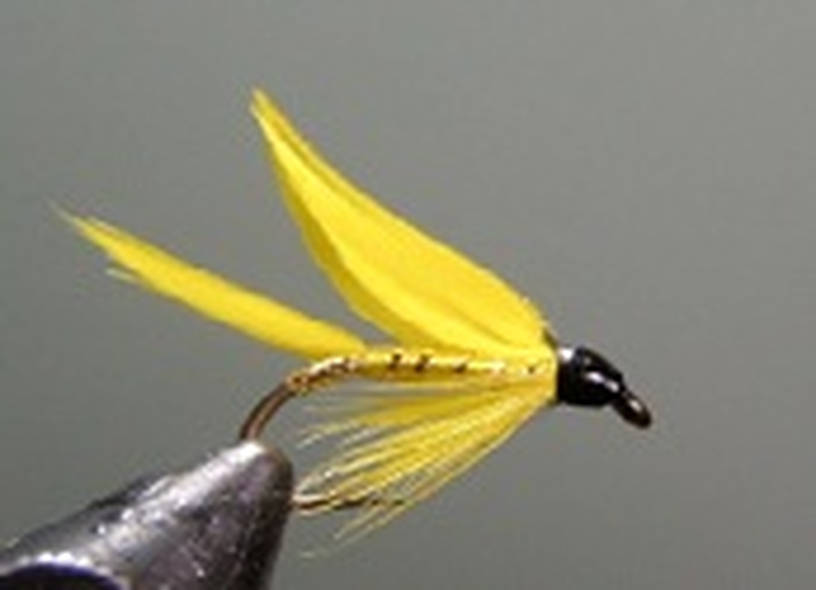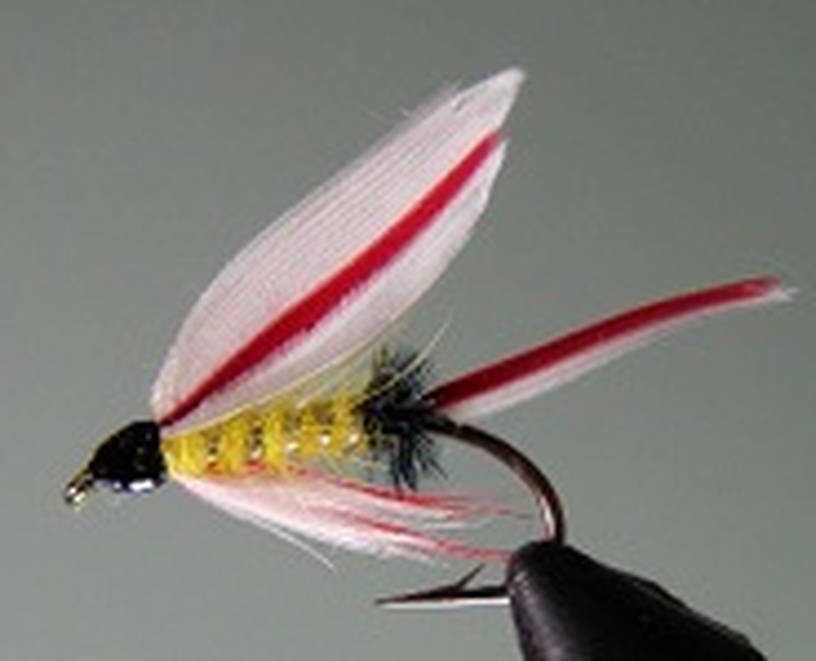Blog & Latest Updates
Fly Fishing Articles
Insects by Common Name


> > Classic Wets
Lastchance has attached these 2 pictures. The message is below.
| Lastchance | December 24th, 2010, 12:24 pm | |
| Portage, PA Posts: 437 | These are the first wets I tied nearly 3 years ago. I stopped because it was hard at the time to get good duck quills. Critiques and suggestions are very welcome. Bruce | |
| Wbranch | December 24th, 2010, 2:00 pm | |
| York & Starlight PA Posts: 2733 | Both look great to me! Far better than anything I could coax out of my vise. Nicely lacquered heads. I always go the extra mile to make my heads nicely tapered with very glossy heads. The proportions of the tail, body, wings, and throat hackle look pretty good too. | |
| Catskill fly fisher for fifty-five years. | ||
| Softhackle | December 24th, 2010, 4:48 pm | |
Site Editor Wellsville, NYPosts: 540 | Bruce, Your flies are looking good. Have you seen the classics tied by Don Bastian or Andy Brasko? Andy posts to a number of forums and is a good man. I've spoken with him, in person, and we hit it off right away. I do not know Don, but he is known for his classic wets. Andy goes by the screen name of Fontinalis. I admire any type of well tied fly, wet, dry. streamer, nymph. it makes no difference. They are all beautiful in their own right. Most people know me for my wingless wets, but I tie all sorts of flies. Being raised in NY, my initial tying consisted of Catskill dry flies. I just don't use or love them as much as the wets. here's one of my favorites I call a "Genesee Jewel". It's a take off on a Light Cahill, but much blonder and ribbed with pearl mylar tinsel.  By the way, Nice tie Wbranch. Mark | |
| "I have the highest respect for the skilled wet-fly fisherman, as he has mastered an art of very great difficulty." Edward R. Hewitt Flymphs, Soft-hackles and Spiders: http://www.troutnut.com/libstudio/FS&S/index.html | ||
| Wbranch | December 25th, 2010, 4:31 am | |
| York & Starlight PA Posts: 2733 | Lastchance, The fly you forgot the name of is a Parmachene Belle. It is a very old married wing wet fly that was likely tied to catch the Eastern brook trout that was native to many rivers in the 19th to mid 20th century. Here is a link to the history of the fly. http://www.flyfishohio.com/Parmechene_Belle.htm | |
| Catskill fly fisher for fifty-five years. | ||
| JAD | December 25th, 2010, 7:42 am | |
 Posts: 362 | Bruce Well done ,not only tied well but it will look good stuck in Tonies shirt when you back cast. I don"t think they will do well on your beloved Tricos Best John | |
| They fasten red (crimson red) wool around a hook, and fix onto the wool two feathers which grow under a cockís wattles, and which in colour are like wax. Radcliffe's Fishing from the Earliest Times, | ||
| Lastchance | December 25th, 2010, 8:50 am | |
| Portage, PA Posts: 437 | What? I thought those were trico killers. I better debarb the hooks. Bruce | |
| Entoman | March 9th, 2011, 10:49 am | |
| Northern CA & ID Posts: 2604 | Hi Bruce, Ditto Matt's comments. The wet fly whose name you couldn't remember is a variation of the Parmachene Belle. The peacock butt is optional, but the original had a floss body. One of the class of "gaudy" brook trout flies that was very popular up to the early part of the last century. The popularity of this fly as well as most of the entire class gradually fell out of favor with the ascendance of the Brown Trout and spin fishing. The bucktail streamer version is still used by many in the western mountain region of Maine, which is where I've had good success with this fly. Regards, Kurt | |
| "It's not that I find fishing so important, it's just that I find all other endeavors of Man equally unimportant... And not nearly as much fun!" Robert Traver, Anatomy of a Fisherman | ||
| Lastchance | March 13th, 2011, 4:41 am | |
| Portage, PA Posts: 437 | Hi All. I've decided I may try to fish a few of these this year. Thing is after I tie a few of these they look so cool I hate to fish them. I just love the colors and feather combinations. Bruce | |
| Jmd123 | March 13th, 2011, 12:19 pm | |
| Oscoda, MI Posts: 2611 | Bruce, let us know how you do on those wets. I haven't tied any wets myself for a while, having become pretty much a dry fly and streamer kind of guy. Mark, your Genesee Jewel is also beautiful. You guys have inspired me to do some when I decide to get out the tying goodies, which might be a little while yet after two months of continuous microscope work - hard to convince my eyes and back to get into more tedious work when I am not getting paid for it! When Spring finally gets here, though (more wet snow today, neither skiable nor walkable), those fishies will further inspire me. Not only that, but some time in the past few years there was an article in one of the flyfishing magazines (which I should be archiving instead of giving away because I can never remember which one) which had photos & recipes for a whole bunch of classic wet flies, many of which were brightly and beautifully colored as are Bruce's. The article pointed out that many if not most of these flies had fallen out of use in favor of more modern designs, so it was a good idea to start tying and fishing them again because the fish that had once seen them were all long since dead...perfect medicine for those "educated fisheries". "What goes around comes around"...or maybe "What is old is new again." Also, Matt, nice streamer! Is that a Clouser variant? I should whip off some of those as well. MY KBF variants will be in "heavy rotation" too when the snow finally leaves. Gotta find more natural grizzly marabou! Jonathon | |
| No matter how big the one you just caught is, there's always a bigger one out there somewhere... | ||
| Gutcutter | March 14th, 2011, 3:55 am | |
| Pennsylvania Posts: 470 | Mark Any tips on tying really small wets and softies? I'm talking 22 and 24. It may seem funny, but I have sometimes done well during the hatch (not the spinner fall) with trico dries when they sink and swing. I tried to spin the hackle as i pull it back away from the eye, but it never distributes evenly. Probably doesn't matter, but I'd like to fish a "wetfly" when I'm using a wet fly. Tony | |
| All men who fish may in turn be divided into two parts: those who fish for trout and those who don't. Trout fishermen are a race apart: they are a dedicated crew- indolent, improvident, and quietly mad. -Robert Traver, Trout Madness | ||
| Softhackle | March 14th, 2011, 7:33 am | |
Site Editor Wellsville, NYPosts: 540 | Hi Tony, Tiny wets are tough because you need hackle that is small enough. The genetic hen necks of today, do offer some smaller hackles that might work for you. Look to the brand names like Whiting. Bird feathers are very hard to find this small but starling has some very small feathers on it. On a regular skin, you will find some black, dark dun and medium dun feathers. I have also seen bleached starling for sale. The starling will be very delicate, so a light touch is required. Next, wrap the hackle as a collar, two turns is good. Then, using your thumb and forefinger of the non-tying hand, carefully pull the hackles fibers back over the body and hold them there while you slightly over-wrap them with the tying thread. Two-three turns will work This sets them in a slightly back-swept position. You should be using very fine tying thread, of course. Benecchi offers 12/0 threads in various colors. Tying really small requires pretty nimble fingers, which I'm sure you have. Magnification helps as well. Don't give up, persistence pays off. Mark | |
| "I have the highest respect for the skilled wet-fly fisherman, as he has mastered an art of very great difficulty." Edward R. Hewitt Flymphs, Soft-hackles and Spiders: http://www.troutnut.com/libstudio/FS&S/index.html | ||
| Entoman | March 15th, 2011, 10:26 am | |
| Northern CA & ID Posts: 2604 | Hi Tony, I also like using soft hackles for tiny Baetis spinners as well. There aren't any soft hackle feathers whose barbules will approximate hook shank length and yet have quills long enough to be practical. I tried folding and wrapping hen hackle by the tip. They looked beautiful, but were way too much work. Also, genetic hen is still pretty stiff, if you can even find any this small. Unfortunately, the only method that works for really tiny Soft Hackles is not to wrap hackle at all. But like you, I never liked the "pull back" method. Very difficult to measure for appropriate length, ditto barbule distribution, and it makes for a bulky head. What I like to do is take a small bunch of stripped barbules (like you would for tying a dry fly tail)from the softest, thin fibered lt. dun feather you can find (I have an old, very soft, lt. dun dyed India neck that I use for this). Measure them in for the appropriate length and place TWO medium pressured thread wraps around them over bare wire. Use your thumb and forefinger to distribute the barbules with a clockwise movement (assuming clockwise tying). The finished fly will look a little more rakish than when the hackle is wound, but this can be worked around by building up the shoulder a little more than normal. Once the hackle is distributed, you can wrap back towards the shoulder to splay them to your liking. As with any technique, the more you do it the better you'll get at distributing the hackle with the thread wraps, needing very little assistance from your fingers. Stay away from the polyester threads (doesn't stretch and grips too well). Best is unwaxed nylon. For small neat heads, finish the shoulder (thorax) pretty close to the eye. Takes a little practice, but I think you will be happy with the results when you get it down. Hope this helps. Regards, Kurt P.S. I'm going to take some pics with my new camera and down load them so you can see the results. (Assuming I can figure it all out). | |
| "It's not that I find fishing so important, it's just that I find all other endeavors of Man equally unimportant... And not nearly as much fun!" Robert Traver, Anatomy of a Fisherman | ||
| Softhackle | March 15th, 2011, 2:59 pm | |
Site Editor Wellsville, NYPosts: 540 | Tony, one other option. Substitute ostrich herl in place of the hackle. You won't need many turns. Ostrich is very soft, but it does work. I've used it myself. Kurt and Tony Stiffer genetic hen does work if you can find them small enough. They don't colapse as readily as bird feather or soft hen. Leisenring use to vary the stiffness of the hackle according to water speed. In many instances he used cockerel hackle for his wets. Cockerel is a young rooster with hackles very similar to genetic hen. Mark | |
| "I have the highest respect for the skilled wet-fly fisherman, as he has mastered an art of very great difficulty." Edward R. Hewitt Flymphs, Soft-hackles and Spiders: http://www.troutnut.com/libstudio/FS&S/index.html | ||
| Entoman | March 15th, 2011, 11:48 pm | |
| Northern CA & ID Posts: 2604 | Mark - Ostrich is an excellent idea! And it CAN be folded as well. Since you want the barbules to go a little past the body (like the wings do) it would work well for the tiny hooks. Don't have any lt. dun (which I think simulates clear spinner wings the best), but I'll give it a try w/ white to check out the idea and report back. Regards, Kurt | |
| "It's not that I find fishing so important, it's just that I find all other endeavors of Man equally unimportant... And not nearly as much fun!" Robert Traver, Anatomy of a Fisherman | ||
| Lastchance | March 16th, 2011, 1:29 pm | |
| Portage, PA Posts: 437 | Tony. Don't forget there is the split thread technique, remember? I tied some trico size 24 dun hackle wets with them last year and they fooled the fish. I can show you the technique if you're not familiar with it. Bruce | |
| Entoman | March 17th, 2011, 11:46 am | |
| Northern CA & ID Posts: 2604 |  Tony - Here's the Olive Quill Soft Hackle Spinner using the hackling method I described earlier in the thread. I tie the same fly for Tricorythodes only substituting grey quill (the gravid females have olive abdomens, but not when they're spent) and blackish brown dubbing. Grey thread for the abdomen, black to finish the fly. Also tie the bodies much fuller since they are a lot stouter than Baetis. For the males I use black quill. You could use white for the tails, but I don't bother. Hook: TMC 500U #22 (eq. to regular length #24) Thread: olive 70 denier Ultra Thread (nylon, unwaxed) Abdomen: stripped olive/green saddle, near the tip (soak it well) Thorax: Wapsi Superfine #091 brown olive Tails and Hackle: Lt. dun lowgrade rooster or hen barbules ( I have a forty year old low grade photo dyed india neck perfect for the purpose) regards, Kurt | |
| "It's not that I find fishing so important, it's just that I find all other endeavors of Man equally unimportant... And not nearly as much fun!" Robert Traver, Anatomy of a Fisherman | ||
| Softhackle | March 17th, 2011, 5:52 pm | |
Site Editor Wellsville, NYPosts: 540 | Nice little wingless wet, Kurt. Good job on the photo, too. Mark | |
| "I have the highest respect for the skilled wet-fly fisherman, as he has mastered an art of very great difficulty." Edward R. Hewitt Flymphs, Soft-hackles and Spiders: http://www.troutnut.com/libstudio/FS&S/index.html | ||
| Entoman | March 18th, 2011, 12:48 pm | |
| Northern CA & ID Posts: 2604 | Thanks Mark. Not bad for starters I guess. The only disapointment is that it makes the hackle barbules look like they're different lengths. For some reason the lateral ones on the near and far sides appear shorter when they are actually all identical. It's the angles? Kurt | |
| "It's not that I find fishing so important, it's just that I find all other endeavors of Man equally unimportant... And not nearly as much fun!" Robert Traver, Anatomy of a Fisherman | ||
| Lastchance | March 19th, 2011, 5:06 am | |
| Portage, PA Posts: 437 | Let me try to explaiin the split thread technique, it allows you to use almost any hackle. Put your body on the fly and leave the thread hanging. Get a needle, I use a sew machine needle, but anything small will work, and split the thread. Insert one side of the hackle feather in the split thread and adjust the the length of the feathers to what size you want. Cut the feathers fibers off and then spin your thread to lock the fibers in the thread. Fold your hackle as you wind it around the hook shenk and tie off. It's like the split thread dubbing technique. Like i said, I've tied size 24 and 26 trico emerger with this method. The Best, Bruce | |
| Lastchance | March 19th, 2011, 5:26 am | |
| Portage, PA Posts: 437 | Here is a hackling method by Charlie Craven, although he didn't come up with the idea. http://www.charliesflyboxinc.com/flybox/details.cfm?parentID=155 | |
Quick Reply
You have to be logged in to post on the forum. It's this easy:
Related Discussions
| Title | Replies | Last Reply |
| Re: Partridge Under-Feathers In Fly Tying by CAuletta | 2 | Jun 7, 2012 by CAuletta |
| Re: imitation? In Cheumatopsyche Caddisfly Pupa by Flytyer0423 | 4 | Oct 5, 2012 by Sayfu |
| Mosquito Adams In Fly Tying by Mcflyangler | 0 | |
| Re: emerger fishing In General Discussion by Turboboy | 4 | Oct 28, 2011 by Sayfu |
| Re: I don't know how this slipped by me!!! In Fly Tying by Oldredbarn | 3 | Mar 20, 2013 by Sayfu |
| Re: woolly bugger body hackle In Fly Tying by Flyman2 | 11 | Apr 11, 2015 by Jmd123 |
| Re: The vanishing wet fly In Fly Tying by GoofusBug | 2 | Jan 7, 2009 by Softhackle |
| Re: Help with Early Spring Stoneflies In the Identify This! Board by Wiflyfisher | 13 | Mar 30, 2021 by Taxon |
| Re: BodyColor? In Capniidae Stonefly Adult by DarkDun | 12 | Jan 11, 2007 by Softhackle |
| Re: Wisconsin Fly Fishing In General Discussion by GldstrmSam | 2 | Apr 7, 2014 by GldstrmSam |
Troutnut.com is copyright © 2004-2024 Jason
Neuswanger (email Jason). See my FAQ for information about use of my images.
 privacy policy
privacy policy







